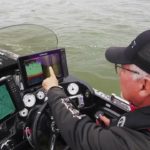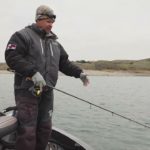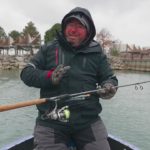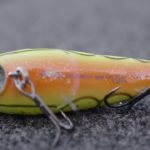Your Best Ice Season Ever
 Here’s a toast to your best ice season ever.
Here’s a toast to your best ice season ever.
To help you get off to a good start, here are a few key things you can do.
They’re all important, but in no particular order.
Keep Your Line Prime
One of the most important– and universally overlooked– things you can do: keep the line on all your ice reels is good shape.
Dave Genz, the man who changed ice fishing forever and continues to refine his approach, talks about taking care of the final 50 feet.
“It’s always better to fish with new line,” says Genz. “Good line, properly cared for, doesn’t spin and twist as much.”
Let’s talk about just the spinning factor for a second.
If you’re going to make this your best ice season ever, you simply have to do something about the tendency for your bait to spin around whenever you aren’t actively jigging it. Many ice anglers don’t even realize this is a problem. Because you’re fishing straight up and down, any time your line has twist in it, all that twist ‘untwists’ whenever the lure is at rest.
You’re jigging away, things look good, and a fish comes in to take a look. But when you pause the jigging sequence, the lure begins to twist around like a figure skater going into the final flurry. Who knows what the fish thinks about that, but in the real world it doesn’t usually help you get the fish to bite.
In the old days, Genz used to talk about waiting for all the spin to come out of the line, and then the fish might bite. These days, he talks about taking care of his line instead.
“Make it a habit to put 50 feet of new line on regularly,” he says. “I’ll take 50 feet of line off my reel, then pre-stretch the new line after I replace it. Just take an arm-length at a time and actually pull it, so the kinks come out of it, so your jig hangs straighter.
“You have to get the coils out of the line. With new line, we’re not talking twist, we’re talking the memory coils.”
Even with new and pre-stretched line, try to avoid reeling like a madman when the drag is slipping as you fight a fish. You know the sound. That introduces twist into the line. Plus, it weakens the line, something that can become an issue when you hook a big one.
“Constant fish catching will weaken your line because it twists,” says Genz. “Twisted line, after a while, is not as strong as it was. Slipping the drag puts twist in the line. It’s hard not to have this happen when you’re out there a lot.”
The best cure is to change the final 50 often, and pre-stretch it.
If you do nothing different other than this, you will catch more fish through the ice this winter. And you will keep fish from getting dizzy watching your lure spin around.
 Extending the Bite: Glow Baits
Extending the Bite: Glow Baits
To Genz and the people who fish with him frequently, there is no debate anymore about whether Techni-Glo jigs typically catch more fish when visibility is a factor.
Under bright sunny conditions in clear, shallow water, glowing colors are not a make-or-break factor. But before the sun comes up in the morning and as darkness invades at late afternoon, the good bite can be extended with glow colors, because fish can see your bait better.
Dave’s original jig designs– Genz Worm, Fat Boy, Genz Bug– along with more recent models like the Rattl’n Flyer Spoon and Frostee Jigging Spoon, are all adorned with Techni-Glo finishes. But that doesn’t mean they automatically glow!
They are ‘chargeable’ meaning that they must be introduced to bright light before being sent down there below the ice. The Tazer is the tool of choice for charging glow baits.
Plastic tails, which are becoming more popular every winter, are available as Techni-Glo Tails or in non-glowing models in the Munchies series.
Even during daylight hours, bait visibility is a factor in deeper water, in heavy weeds or other cover, and in dirty water. In the winter, daylight hours give way to darkness before most people get home from work. This is a factor that needs to be considered! If you fish with Techni-Glo jigs and tails, whenever you suspect it will help fish see your offering, you will catch more fish this season.
Catching More Fish at Early Ice
Early ice is one of the best chances you have, all year, to catch a bunch.
Fish are relatively more at peace with their surroundings, for one thing. During ice-up, there is almost no fishing or boating pressure. Even after ice becomes ‘walkable,’ many anglers are reluctant to be first to shuffle across the groaning, cracking surface.
Not Genz. He straps on a life jacket, grabs the chisel, and checks the ice as he walks, knowing that early ice is really a continuation of late fall, a time when fish are looking to feed throughout the shrinking daylight hours.
He knows that if he can approach quietly, the fish are in the mood to play.
“That’s the game at first ice,” says Genz. “The fish are out there cruising around, and they want to eat. But you can’t spook ‘em.”
He’s said it before, but it bears repeating: the sun hangs low in the sky from daybreak to sunset, and the morning bite extends into the evening bite. It’s all prime time, assuming you can get on the fish.
Stealth is a huge factor at early ice, because thin, clear ice tends to magnify movements and noises. Careless walking, scraping and cutting will send fish scattering before you can put a bait down there.
But if you are quiet and offer them something that looks right, the fishing can be fast.
Safety is a must. Wear a life jacket, go with at least one other person, tell people where you went and when to expect you back.
Always test the ice thickness ahead of you, with a chisel.
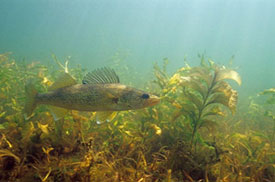
Understanding Early Ice
Much more than most anglers realize, early ice is simply a continuation of late fall.
By keeping track of late fall weather, you can look in the right places at early ice.
“So much depends on what the weather was like during the fall,” says Genz. “If the winds are calm and we have lots of sunshine in late fall, weeds can start growing again in shallow water. The weeds might die and lay down when the first cold fall weather comes, then here comes this nice weather and they start growing again. Bug hatches can occur in the shallows if the weather is warm, too, and that can make fish stay shallower.”
If there is life in the shallows right before freeze-up, that life will still be there after the ice gets thick enough to fish through. “It’s a chain reaction,” says Genz. “If the panfish are in there, that brings in the walleyes, pike and bass.”
By no means is he suggesting that every fish in the lake will be shallow, even under the mildest of late fall and early ice conditions. “But there can be a lot of fish shallow,” says Genz, “and they can stay shallow well into the winter, if the weeds are healthy and there’s food in there.”
First thing you should do, as soon as you venture out onto early ice:
Look shallow, checking the condition of shallow weeds.
If they look healthy, suspect shallow fish.
“But if we have one of those nasty falls,” says Dave, “where it’s rainy, cloudy, snowy, windy, you’re more likely to find most of the fish deeper right away.”
Movements fish make in response to late fall weather patterns, it seems, are not long in distance, but simply to one general depth level or another. In other words, if they are not in the shallow, weedy bays, they might be just outside, even in the deeper weeds, or at the base of the first dropoff.
Create Your Own Dark Spot
At early ice, or anytime there is little snow cover, movements above the ice will cause fish to instinctively hide. “When a bird flies over in the summertime,” says Genz, “the fish all scatter.”
If you can find patches of snow, drift over to them and fish on them, if you have a choice. It’s darker below the snow, making fish feel more comfortable about venturing out to eat.
Any time this is a factor, realize the value of fishing from inside a portable shelter.
“Sit in your Fish Trap,” says Genz, “and the fish might actually move over to those shadows you created. It can be a big advantage, when you make that dark spot.”
Time to Fish Smaller Waters
Early ice is the best time to fish ponds or smaller lakes, the kind of fishery that shuts down big-time after winter wears on.
“For one thing,” says Genz, “the small lake is frozen. When you still don’t have any ice on the big lakes, the smaller lakes can be ready.
“This is the time to go check out that small lake back in the woods, the one you’re thinking might be a good spot. If you go there in February, you usually catch nothing. But if you go there as soon as the ice is safe, you usually catch fish.”
Added bonus: you are a big fisherman on a small pond.
“On a big body of water,” says Genz, “you can feel so small out there. You wonder how you could ever cover it. But a smaller lake, you can cover the whole thing in an afternoon.”
Note: Dave Genz, known as Mr. Ice Fishing, was the primary driver of the modern ice fishing revolution. For more, including his instructional DVD on bluegill fishing, go to www.davegenz.com, and www.iceteam.com.


